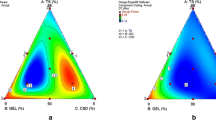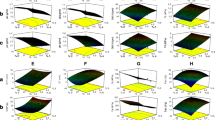Abstract
The purpose of this study is to illustrate, with a controlled example, the influence of raw material variability on the excipient’s functionality during processing. Soluble starch was used as model raw material to investigate the effect of variability on its compaction properties. Soluble starch used in pharmaceutical applications has undergone a purification procedure including washing steps. In this study, a lot of commercially available starch was divided into two parts. One was left intact and the other was subjected to an extra washing step. The two resulting lots were subjected to a series of physical characterization tests typical of those used to qualify raw materials. The two resulting lots gave virtually identical results from the tests. From the physical testing point of view, the two lots can be considered as two equivalent lots of the same excipient. However, when tested for their functionality when subjected to a compaction process, the two lots were found to be completely different. The compaction properties of the two lots were distinctly different under all environmental and processing conditions tested. From the functionality point of view, the two lots are two very different materials. The similar physical testing results but different functionality can be reconciled by considering the surface properties of the powders. It was found that the washing step significantly altered the surface energetic properties of the excipient. The washed lot consistently produced stronger compacts. These results are attributable to the measurably higher surface energy of induced by the additional washing step.








Similar content being viewed by others
References
Bochner F, Tyrer JH, Hooper WD, Eadie MJ. Factors involved in an outbreak of phenytoin intoxication. J Neurol Sci. 1972;16(4):481–7.
Tyrer JH, Eadie MJ, Sutherla JM, Hooper WD. Outbreak of anticonvulsant intoxication in an Australian city. Br Med J. 1970;4(5730):271–3.
Landin M, Gonzalez MP, Souto C, Concheiro A, Gomezamoza JL, Martinezpacheco R. Comparison of 2 varieties of microcrystalline cellulose as filler-binders. 2. Hydrochlorothiazide tablets. Drug Dev Ind Pharm. 1993;19(10):1211–20.
Landin M, Martinezpacheco R, Gomezamoza JL, Souto C, Concheiro A, Rowe RC. Effect of country-of-origin on the properties of microcrystalline cellulose. Int J Pharm. 1993;91(2–3):123–31.
Landin M, Martinezpacheco R, Gomezamoza JL, Souto C, Concheiro A, Rowe RC. Influence of microcrystalline cellulose source and batch variation on the tabletting behavior and stability of prednisone formulations. Int J Pharm. 1993;91(2–3):143–9.
Landin M, Martinezpacheco R, Gomezamoza JL, Souto C, Concheiro A, Rowe RC. Effect of batch variation and source of pulp on the properties of microcrystalline cellulose. Int J Pharm. 1993;91(2-3):133–41.
Landin M, Vazquez MJ, Souto C, Concheiro A, Gomezamoza JL, Martinezpacheco R. Comparison of 2 varieties of microcrystalline cellulose as filler-binders. 1. Prednisone tablets. Drug Dev Ind Pharm. 1992;18(3):355–68.
Symecko CW, Rhodes CT. The effect of compaction force and type of pregelatinized starch on the dissolution of acetaminophen. Drug Dev Ind Pharm. 1997;23(3):229–38.
Doelker E. Comparative compaction properties of various microcrystalline cellulose types and generic products. Drug Dev Ind Pharm. 1993;19(17–18):2399–471.
Sam T. Regulatory implications of excipient changes in medicinal products. Drug Inf J. 2000;34(3):875–94.
Maincent P. Potential problems when switching from one excipient to another in drug formulation. Therapie. 1999;54(1):5–10.
R. B. Casagrande, S. R. Georgetti, W. A. Verri, J. R. Jabor, A. C. Santos, and M. J. V. Fonseca. Evaluation of functional stability of quercetin as a raw material and in different topical formulations by its antilipoperoxidative activity. AAPS PharmSciTech 7(1), (2006).
Timmins P, Browning I, Delargy AM, Forrester JW, Sen H. Effect of active raw-material variability on tablet production—physicochemical, physicomechanical and pilot-plant studies. Drug Dev Ind Pharm. 1986;12(8–9):1293–307.
Barra J, Somma R. Influence of the physicochemical variability of magnesium stearate on its lubricant properties: possible solutions. Drug Dev Ind Pharm. 1996;22(11):1105–20.
Bracconi P, Andres C, Ndiaye A. Structural properties of magnesium stearate pseudopolymorphs: effect of temperature. Int J Pharm. 2003;262(1–2):109–24.
Bracconi P, Andres C, N'Diaye A, Pourcelot Y. Thermal analyses of commercial magnesium stearate pseudopolymorphs. Thermochim Acta. 2005;429(1):43–51.
Zhao N, Augsburger LL. The influence of product brand-to-brand variability on superdisintegrant performance: a case study with croscarmellose sodium. Pharm Dev Technol. 2006;11(2):179–85.
Whiteman M, Yarwood RJ. Variations in lactose NF from 2 different sources and their influence on tablet properties. Drug Dev Ind Pharm. 1990;16(11):1815–27.
O'Neil MJ. The Merck index : an encyclopedia of chemicals, drugs, and biologicals. 13th ed. Whitehouse Station: Merck; 2001. p. 8878.
Hoover R. Acid-treated starches. Food Rev Int. 2000;16(3):369–92.
Srichuwong A, Isono N, Mishima T, Hisamatsu M. Structure of lintnerized starch is related to X-ray diffraction pattern and susceptibility to acid and enzyme hydrolysis of starch granules. Int J Biol Macromol. 2005;37(3):115–21.
Wierik G, Eissens AC, Besemer AC, Lerk CF. Preparation, characterization, and pharmaceutical application of linear dextrins. 1. Preparation and characterization of amylodextrin, metastable amylodextrins, and metastable amylose. Pharm Res. 1993;10(9):1274–9.
ASTM E 104-02, Standard practice for maintaining constant relative humidity by means of aqueous solutions. 2002, ASTM International.
Amin MCI, Fell JT. Tensile strength and bonding in compacts: a comparison of diametral compression and three-point bending for plastically deforming materials. Drug Dev Ind Pharm. 2002;28(7):809–13.
Stanley P. Mechanical strength testing of compacted powders. Int J Pharm. 2001;227(1–2):27–38.
Tye CK, Sun CC, Amidon GE. Evaluation of the effects of tableting speed on the relationships between compaction pressure, tablet tensile strength, and tablet solid fraction. J Pharm Sci. 2005;94(3):465–72.
Joiris E, Di Martino P, Berneron C, Guyot-Hermann AM, Guyot JC. Compression behavior of orthorhombic paracetamol. Pharm Res. 1998;15(7):1122–30.
Sun CQ, Grant DJW. Influence of crystal structure on the tableting properties of sulfamerazine polymorphs. Pharm Res. 2001;18(3):274–80.
Heckel RW. An analysis of powder compaction phenomena. Trans Metall Soc AIME. 1961;221(5):1001–8.
Heckel RW. Density–pressure relationships in powder compaction. Trans Metall Soc AIME. 1961;221(4):671–5.
Ryshkewitch E. Compression strength of porous sintered alumina and zirconia, 9th Communication to Ceramography. J Am Ceram Soc. 1953;36(2):65–8.
Newton JM, Mashadi AB, Podczeck F. The mechanical-properties of an homologous series of benzoic-acid esters. Eur J Pharm Biopharm. 1993;39(4):153–7.
Schultz J, Lavielle L, Martin C. The role of the interface in carbon-fiber epoxy composites. J Adhes. 1987;23(1):45–60.
Mukhopadhyay P, Schreiber HP. Aspects of acid–base interactions and use of inverse gas-chromatography. Colloid Surf A—Physicochem Eng Asp. 1995;100:47–71.
Cheetham NWH, Tao LP. Variation in crystalline type with amylose content in maize starch granules: an X-ray powder diffraction study. Carbohydr Polym. 1998;36(4):277–84.
Bates S, Zografi G, Engers D, Morris K, Crowley K, Newman A. Analysis of amorphous and nanocrystalline solids from their X-ray diffraction patterns. Pharm Res. 2006;23(10):2333–49.
Roberts RJ, Rowe RC, York P. The relationship between the fracture properties, tensile-strength and critical stress intensity factor of organic-solids and their molecular-structure. Int J Pharm. 1995;125(1):157–62.
Sun CC. A material-sparing method for simultaneous determination of true density and powder compaction properties—aspartame as an example. Int J Pharm. 2006;326(1–2):94–9.
Gupta A, Peck GE, Miller RW, Morris KR. Influence of ambient moisture on the compaction behavior of microcrystalline cellulose powder undergoing uni-axial compression and roller-compaction: a comparative study using near-infrared spectroscopy. J Pharm Sci. 2005;94(10):2301–13.
Sun CQ. A novel method for deriving true density of pharmaceutical solids including hydrates and water-containing powders. J Pharm Sci. 2004;93(3):646–53.
Nokhodchi A, Rubinstein MH. An overview of the effects of material and process variables on the compaction and compression properties of hydroxypropyl methylcellulose and ethylcellulose. STP Pharma Sci. 2001;11(3):195–202.
Suzuki T, Nakagami H. Effect of crystallinity of microcrystalline cellulose on the compactability and dissolution of tablets. Eur J Pharm Biopharm. 1999;47(3):225–30.
Nicolas V, Chambin O, Andres C, Rochat-Gonthier MH, Pourcelot Y. Preformulation: effect of moisture content on microcrystalline cellulose (Avicel PH-302) and its consequences on packing performances. Drug Dev Ind Pharm. 1999;25(10):1137–42.
Khan F, Pilpel N, Ingham S. The effect of moisture on the density, compaction and tensile strength of microcrystalline cellulose. Powder Technol. 1988;54(3):161–4.
Petteri P, Jukka I. Porosity–pressure functions. In: Alderborn G, Nystrèom C, editors. Pharmaceutical powder compaction technology. New York: Marcel Dekker; 1996. p. 15. 610 p.
Shotton E, Obiorah BA. Effect of physical-properties on compression characteristics. J Pharm Sci. 1975;64(7):1213–6.
Wang CC. Mechanical properties and compaction properties of pharmaceutical pellets. Austin: The University of Texas at Austin; 1997. p. 254.
Nardin M, Papirer E. Relationship between vapor-pressure and surface-energy of liquids—application to inverse gas-chromatography. J Colloid Interface Sci. 1990;137(2):534–45.
Acknowledgment
National Science Foundation 000364-EEC, Dane O. Kildsig Center for Pharmaceutical Processing Research.
Author information
Authors and Affiliations
Corresponding author
Rights and permissions
About this article
Cite this article
Chamarthy, S.P., Pinal, R. & Carvajal, M.T. Elucidating Raw Material Variability—Importance of Surface Properties and Functionality in Pharmaceutical Powders. AAPS PharmSciTech 10, 780–788 (2009). https://doi.org/10.1208/s12249-009-9267-5
Received:
Accepted:
Published:
Issue Date:
DOI: https://doi.org/10.1208/s12249-009-9267-5




